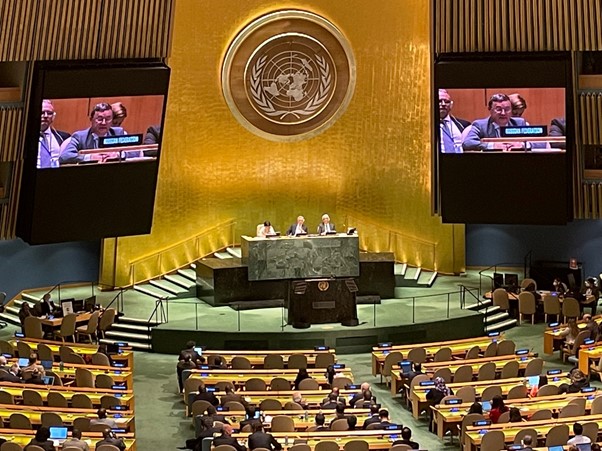RECNA NPT Blog 2022 Final Edition No.2
2. Growing Conflict and Faint “Light”: The Ukraine Issue and Nuclear Risk Reduction

Photo: On the final day of the NPT Review Conference, a Russian delegate asserted that he could not agree with the draft of the final document.
There were various points of contention at the Review Conference, and in addition to Article VI, which stipulates the obligation to disarm, conflicts became apparent on a number of other issues.
Above all, the increased risk of nuclear war following Russia’s invasion of Ukraine and its nuclear threats, the risk of attacks on nuclear facilities such as the Zaporizhzhia nuclear power plant(ZNPP), and the violation of the Budapest Memorandum of Understanding and negative security assurances were barriers to agreement in the draft final document.
Regarding the reduction of the risk of nuclear war, the chair’s first draft included the text of the January 2022 Joint Statement of the Heads of State and Government of the nuclear-weapon States (NWS), “Nuclear war never be fought” was quoted, and it even stated that “nuclear weapons have not been used in 77 years and must never be used in the future.” However, in the draft final document, the reference to the issuance of the joint statement by the leaders remained, but the quote was removed. The “taboo of not using nuclear weapons for 77 years” was also deleted, and the sentence “nuclear weapons are never used again” was added by the statement that “making every effort to ensure”, giving the strong impression that the document has been weakened overall. Nevertheless, the statement “We express our deepest concern that the threat of the use of nuclear weapons is the highest since the Cold War” remains, and it can be said that a certain degree of common understanding of the risk of nuclear war has been achieved.
A substantial statement about an attack on the ZNPP remained, despite Russian opposition. The statement “grave concern for military activities conducted near or at nuclear plants and other facilities,” with “in particular the Zaporizhzhia nuclear power plant,” and concern about “the loss of control over nuclear facilities and other locations prevents the competent Ukrainian authorites,” as well as “their profound negative impact on safety, security, including physical protection of nuclear material, and safeguards,” were also specified. While the first draft clearly stated criticism of “Russia,” the name of the country was removed in the final Draft but it was clear that the final draft was a statement against Russian actions. Furthermore, the importance of lifting the occupation and returning jurisdiction to Ukraine was pointed out, and support for the reinstatement of IAEA inspections was clearly stated. These statements were one of the main reasons for the lack of Russian support.
Although it did not refer to the ZNPP, it was one of the few times that the document clearly stated that the safety of nuclear facilities for peaceful uses of nuclear energy should be ensured, reminding the public of the importance of ensuring the safety and security of nuclear facilities and nuclear materials under any circumstances, even in areas where military operations are taking place. This is one of the few achievements of the conference.
In relation to Ukraine, the statement to the “Budapest Memorandum,” in which the U.S., U.K., and Russia guaranteed Ukraine’s security as a condition for Ukraine’s participation in the NPT, was left until the end, despite Russian opposition. This is believed to be one of the reasons why Russia could not support it. However, the fact that the statement “Russia violated the Budapest Memorandum” was deleted must have been unsatisfactory to Ukraine.
Regardless of the Ukraine issue, opinions on “negative security assurances” have traditionally been divided between the nuclear weapon states and non-nuclear weapon states, and the conflict continued this time over the wording. The draft had stated that “the threat or use of nuclear weapons against non-nuclear weapon states will not be made under any circumstances,” but in the final draft the wording was weakened to ” consistent with their respective national statements” (for details, see Blog 1). As a result, it now means that nuclear weapons can be threatened or used as long as the nuclear weapon states follow their announced policies, as Russia did at the time of its recent invasion of Ukraine. This makes the “negative security assurance” meaningless.
Finally, while the negotiations for the “Treaty on the Prohibition of the Production of Nuclear Material for Nuclear Weapons (FMCT)” were not progressing, the first draft included a “moratorium on the production of fissile material for nuclear weapons”. However, in the final draft, this moratorium clause was also deleted, mainly due to opposition from China.
One of the most notable additions to the agreement on peaceful uses of nuclear energy was the inclusion of a paragraph stating that nuclear energy will play an important role in combating climate change and achieving Sustainable Development Goals (SDGs). In the past, the “inalienable right” to the peaceful use of nuclear energy was explicitly stated, and items that rejected new regulations that would prevent its use were often deleted, but the contribution to climate change countermeasures was never explicitly stated. It was surprising that no particular objections were raised, even from countries that are reluctant to use nuclear power.
(Tatsujiro Suzuki)
















